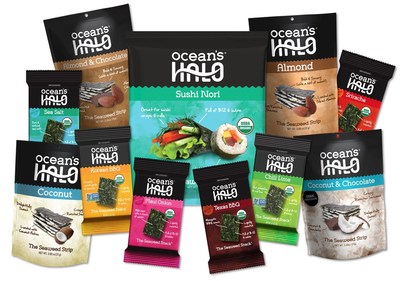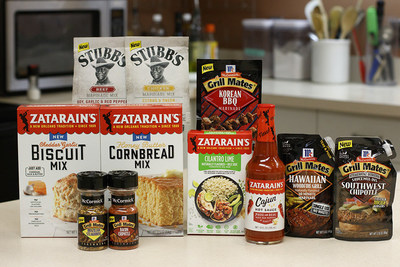New Frontier Foods Expands Ocean's Halo®
Product Line Launching Delightfully Sweet Dark Chocolate Seaweed Strips
- The Seaweed Strip™ with Dark Chocolate Continues Industry-Leading Product Innovation
- Company also adding USDA Organic Sushi Nori to Product Line
- Chili Lime and Korean BBQ Expand Flavors of The Seaweed Snack™ Sheets
- Cerritos, CA Plant Now SQF Certified
BURLINGAME, Calif., Jan. 19, 2017 /PRNewswire/ -- New Frontier Foods, maker
of Ocean's Halo® seaweed products, today announced a significant
expansion to its product lines and manufacturing capabilities debuting at 2017
Winter Fancy Foods show on January 22nd through the 24th
in booth #3000, at the Moscone Center in San Francisco, California. The new
product offerings include:
 Commenting on the expansion, Ocean's Halo® co-founder Robert Mock
noted: "Seaweed shouldn't be boring. Consumers deserve new and interesting
products and we're going to be relentless in our pursuit of product innovation.
We couldn't be more excited about the dark chocolate strips, new flavored sheets
and the organic nori. And stay tuned for another completely new product later
this year."
Commenting on the expansion, Ocean's Halo® co-founder Robert Mock
noted: "Seaweed shouldn't be boring. Consumers deserve new and interesting
products and we're going to be relentless in our pursuit of product innovation.
We couldn't be more excited about the dark chocolate strips, new flavored sheets
and the organic nori. And stay tuned for another completely new product later
this year."
Shoppers can now find Ocean's Halo® Seaweed snack products in Whole Foods, Costco, Albertsons, Safeway & Vons, Ahold, Mollie Stones and a growing number of natural, grocery and specialty markets, co-ops and restaurants in the US and abroad. Ocean's Halo® is also sold on Amazon.com.
Retailers interested in ordering please email sales@oceanshalo.com. For more information about Ocean's Halo® and to find a retailer near you, go to www.oceanshalo.com or join the Ocean's Halo® conversation on Facebook at www.facebook.com/OceansHalo, Twitter and Pinterest @OceansHalo #SwimAgainstTheTide.
About New Frontier Foods Inc. Based in the San Francisco Bay Area, New Frontier Foods Inc. was founded in 2011 by four dads on a mission to leverage the science of superfoods to make ordinary foods delicious and healthy. Ocean's Halo offers totally delicious crispy, crunchy snacks made from USDA Organic, sustainably harvested seaweed. We are proud to donate two percent of our profits to organizations like the Monterey Bay Aquarium's Children's Education Fund program that is inspiring the next generation of ocean evangelists.
- A first-of-its-kind Dark Chocolate Seaweed Strip: Imagine two thin layers of seaweed surrounding a crunchy layer of Almonds or Coconut, with just the right amount of delicious dark chocolate in the middle. Both the Almond and Coconut skus are our highest-ever scoring products in pre-launch taste tests, and are an expansion to The Seaweed Strip™ product line.
- Chile Lime and Korean BBQ Flavors Added to The Seaweed Snack™ Sheets: Our popular USDA Organic sheeted seaweed snacks now have two new flavors – Chili Lime and Korean BBQ – which also remain available in Sea Salt, Maui Onion, Texas BBQ and Sriracha flavors.
- Organic Ocean's Halo ® Sushi Nori – to satisfy growing market demand for at-home sushi products, a high-quality line of organic sushi nori will debut in the Spring 2017
- US Production Facility Now SQF Certified – Our seaweed production facility in Cerritos, California was SQF certified in the fall of 2016.

Shoppers can now find Ocean's Halo® Seaweed snack products in Whole Foods, Costco, Albertsons, Safeway & Vons, Ahold, Mollie Stones and a growing number of natural, grocery and specialty markets, co-ops and restaurants in the US and abroad. Ocean's Halo® is also sold on Amazon.com.
Retailers interested in ordering please email sales@oceanshalo.com. For more information about Ocean's Halo® and to find a retailer near you, go to www.oceanshalo.com or join the Ocean's Halo® conversation on Facebook at www.facebook.com/OceansHalo, Twitter and Pinterest @OceansHalo #SwimAgainstTheTide.
About New Frontier Foods Inc. Based in the San Francisco Bay Area, New Frontier Foods Inc. was founded in 2011 by four dads on a mission to leverage the science of superfoods to make ordinary foods delicious and healthy. Ocean's Halo offers totally delicious crispy, crunchy snacks made from USDA Organic, sustainably harvested seaweed. We are proud to donate two percent of our profits to organizations like the Monterey Bay Aquarium's Children's Education Fund program that is inspiring the next generation of ocean evangelists.
CONTACT: Press@OceansHalo.com






